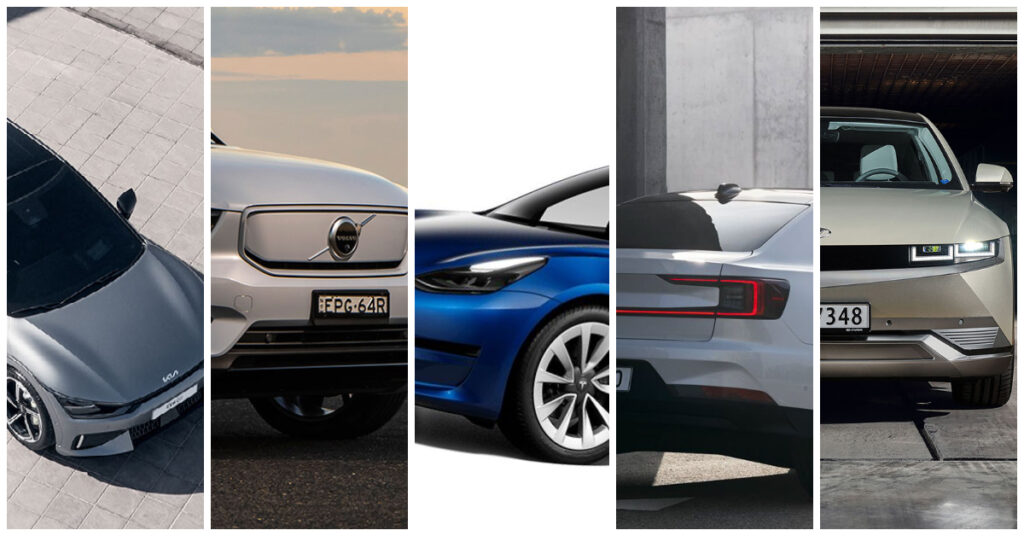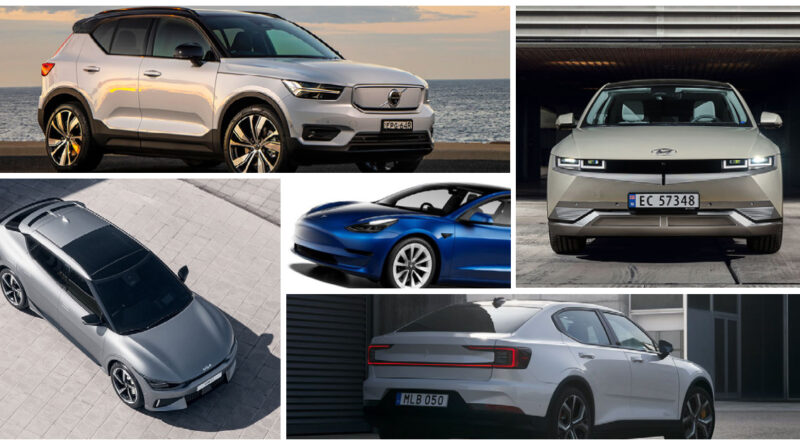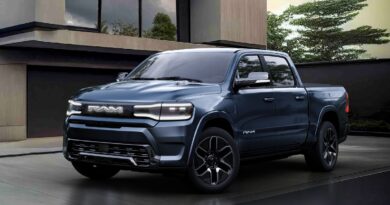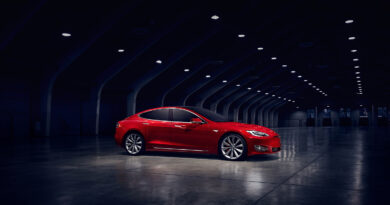Specs comparison: Hyundai Ioniq 5 v Tesla Model 3 v Kia EV6 v Polestar 2 v Volvo XC40 EV
There’s a high-performance sweet spot forming around the $75K mark of the new EV market. And it’s a clash of premium and mainstream brands, each with tech, long driving ranges and brisk acceleration at their heart.
That got us thinking about which is best, on paper (or online!) at least.
To be eligible for this specs comparo we picked models with two motors and a circa-$75K asking price, which allows them to take advantage of some rebates and EV incentives in some states and territories.
That ruled out things such as the Tesla Model 3 Performance and the more affordable Tesla Model 3 Standard Range Plus. Instead we went for the Model 3 Long Range.
UPDATED: Tesla Model 3 updated for November 2021: longer range but slower 0-100km/h time
It also ruled out the Mercedes-Benz EQA250, which is front-drive only (an AWD EQA350 arrives in 2022).
But there’s still plenty to choose from and for this match-up we picked these five contenders:
- Hyundai Ioniq 5 AWD long range
- Kia EV6 AWD long range
- Tesla Model 3 Long Range
- Polestar 2 AWD Long Range Dual Motor
- Volvo XC40 Pure Electric
As you can see from the table below, there are some clear winners in certain categories.
The Tesla Model 3 Long Range, for example, lives up to its name by providing the longest WLTP range of 580km. Like all WLTP ratings, for most drivers they’ll probably get less than that. But, equally, the Tesla is likely to go the furthest before needing a top-up.
In keeping with that, the Tesla is the most efficient according to the WLTP consumption figures; 13.8kWh per 100km is impressive for a car that also steps off the line as smartly as it does. It helps that the Model 3 is narrower and lower than its rivals, so there is less air to push out of the way.
Tesla doesn’t talk power figures, but the concensus is that the Model 3 makes about 340kW (when certifiying the car for sale in Australia Tesla supplied a figure of 366kW).
Want the latest EV news and reviews delivered to your inbox? Subscribe to our newsletter!
Either way, the Tesla looks like it beats its rivals on outright power, something that translates to snappier acceleration. That said, these are all claimed figures and our testing in the past has suggested Tesla can be optimistic.
The Tesla is also the only one of these go-fast EV heroes that can’t tow, with the rest at least able to take a trailer up to 1600kg (for the EV6 and Ioniq 5) or 1500kg (for the Polestar 2 and XC40). Want to know more about towing with an EV? See our complete guide to towing with an electric car.
As for charging, the Hyundai and Kia take the win there courtesy of an electricial architecture capable of taking an 800V charge. There’s some conjecture as to the maximum the EV6 and Ioniq 5 can take, with some suggesting 232kW but Hyundai suggesting more like 350kW. Either way, they look like having the highest peak charge rate of any EV on the market.
For now, all we can tease you with is this specs comparison, but we’ll be comparing all these cars in future, so stay tuned.
Or sign up to our weekly newsletter (see the link above) to have the latest electric car news and reviews delivered to your inbox.
| Hyundai Ioniq 5 AWD | Kia EV6 AWD long range | Tesla Model 3 Long Range | Polestar 2 AWD Long Range Dual Motor | Volvo XC40 Pure Electric | |
| Price (excluding dealer deliver and on-road costs) | $75,900 | $75,000 (estimated) | $73,400 | $69,000 | $76,990 |
| Battery capacity (usable) | 72.6kWh | 77.4kWh | 76kWh* | 75kWh | 75kWh |
| Front motor outputs | 70kW/255Nm | NA | NA | 150kW/330Nm | 150kW/330Nm |
| Rear motor outputs | 155kW/350Nm | NA | NA | 150kW/330Nm | 150kW/330Nm |
| Total output (kW/Nm) | 225kW/605Nm | 239kW/605Nm | 340kW/493Nm* | 300kW/660Nm | 300kW/660Nm |
| 0-100km/h (claimed) | 5.2 seconds | 5.2 seconds | 4.4 seconds | 4.7 seconds | 4.9 seconds |
| WLTP EV range | 430km | 506km (overseas figure) | 580km | 480km | 418km |
| Energy consumption (WLTP) | 19.0kWh/100km | 17.2kWh/100km (overseas figure) | 13.8kWh/100km | 19.0kWh/100km | 25.5kWh/100km |
| AC charging max | 10.5kW | 10.5kW | 11kW | 11kW | 11kW |
| DC charging max | 230kW** | 230kW** | 210kW* | 150kW | 150kW |
| Towing capability | 1600kg | 1600kg (overseas) | Not rated to tow | 1500kg | 1500kg |
| Length/width/height (millimetres) | 4635/1890/1605 | 4695/1890/1545 | 4694/1849/1443 | 4606/1859/1479 | 4425/1863/1652 |
** Hyundai says the Ioniq 5’s E-GMP electrical system can charge at 350kW but overseas reports and our own testing suggest 230kW is more accurate






G’Day
One thing about EV’s, and is never talked about (or if so I haven’t heard about it), is the effects on distance your car will travel when using all your accessorise in the car at the same time, ie Radio, Air Con, car fridge etc. And what other problems might that bring into play.
Where can I test drive a Polestar 2?
Polestar is currently in the process of opening its dealerships, which it refers to as “spaces”. Until then you can click here to register your details for a test drive and they should get in touch to (hopefully) get you behind the wheel.